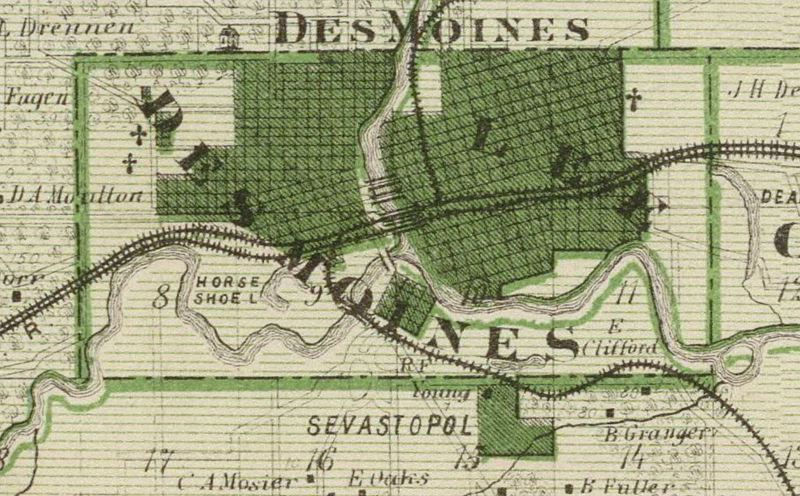
Early 1800s
Along the Dragoon Trail
Have you seen the brown Dragoon Trail signs weaving through the State of Iowa?
The trail follows the path of the 1st U. S. Dragoons, the country's first mounted infantry unit led by Lieutenant Colonel Stephan W. Kearny and Lieutenant Albert Lea, on their historic march in the summer of 1835, to scout Iowa after the Black Hawk Purchase of 1832 put the area under U.S. control.
Through Des Moines, the route led from Water Street across the Raccoon River near the mouth; SE 1st Street across the Des Moines River, then to Scott Avenue, to SE 6th Street, to Hartford Avenue, to SE 22nd, and continued on from there.
Read more:
Late 1800s
Sevastopol and the coal mines
Sevastopol began as a settlement south of Des Moines around 1855. It was laid out by James Sherman, was recorded on July 21, 1862, and incorporated in 1877 or 1878 (varies with source). Its boundaries were SE 5th, Hartford Ave, Bell Avenue and Pioneer Park. It is said to have been named by John Webber after a Russian, now Ukrainian, fortress that was well-known during the Crimean War. A large brewery and the largest coal mine in the county were there. The brewery was located at SE 6th and Hartford Avenue.
The coal mines that were located in the vicinity of the neighborhood included:
Pioneer Coal Co. Mine — (1876 - 1896) Entrance to the mine was near SW 7th
Union Mine - (1887 - 1894) B&B Grocery is situated atop the mine
Gibson Coal Mine - (1889 - 1895) Mine extended from SE 8th past SE 14th
Capital Coal Co. Mine - (1903 - 1908)
Read more
Early 1900s
Little Italy begins to thrive
Italian immigrants from the southern provinces like the Calabria region, came to Des Moines in the 1880s through 1930s looking for a new life—one of hope and opportunity. They took advantage of local economic opportunities and set up shops, businesses, and organizations that helped earned the neighborhood the nickname, Little Italy.
Institutions such as St. Anthony's Church, Vittoria Lodge, Stemma d'Italia, and The American Citizen "... served a dual purpose: they helped Italian-Americans retain a sense of their cultural heritage while encouraging members of the community to take full advantage of the economic, political, and educational opportunities offered in the city of Des Moines." — McCoy, M., (1983) “The Italian Heritage in Des Moines: Photographs”, The Palimpsest 64(2), 58-69.

Into the 21st Century
A bustling community
The McKinley School Columbus Park neighborhood is a culturally-diverse and sought-after area that features well-known businesses and institutions. The area also includes:
bike-friendly layout
easy access to trails and parks
quick access to downtown
shaded, tree-lined residential streets
variety of dining, shops, and service
Come see for yourself what makes this a great place to live.




